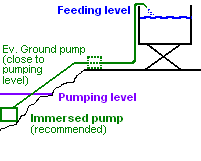|
<< Click to Display Table of Contents >> Pumping: Lake or River to Storage |
  
|
|
<< Click to Display Table of Contents >> Pumping: Lake or River to Storage |
  
|
See also: Pumping Systems: procedure.
Pumping systems from a lake or river are similar to deep well systems, but with some technical simplifications:
- The pump may be placed near the source (no more than 4-5 m above the water surface, less at high altitudes, for avoiding cavitation problems).
- The pump is not necessarily of "Submersible" type, therefore much cheaper. On the other hand, it's maintenance is more easy.
Remember that the Pressure or Head is mainly related to the difference between the input and output levels. The pump has to provide a total head resulting of several contributions.
In PVsyst we take reference to the ground level, we have (cf fig):
HT = HG + HS + HF
where:
HG = head due to the height of the outlet pipe above the ground (assuming that outlet pressure is negligible).
HS = static head due to the depth of the water level, with respect to the ground.
HF = friction losses in the piping circuit, which depend on the flowrate.

For this system, in the "Pumping Hydraulic definitions" dialog, you will be asked to specify:
- The lake or river level depth, with respect to the ground. This may be also be given in seasonal or monthly values, in the "Water Needs" next dialog.
- The Pump depth, may be at most 5 m over the source depth,
You will also define the Storage Tank and Hydraulic circuit parameters.
A little graphical tool shows the total head and its contributions, as a function of flowrate.